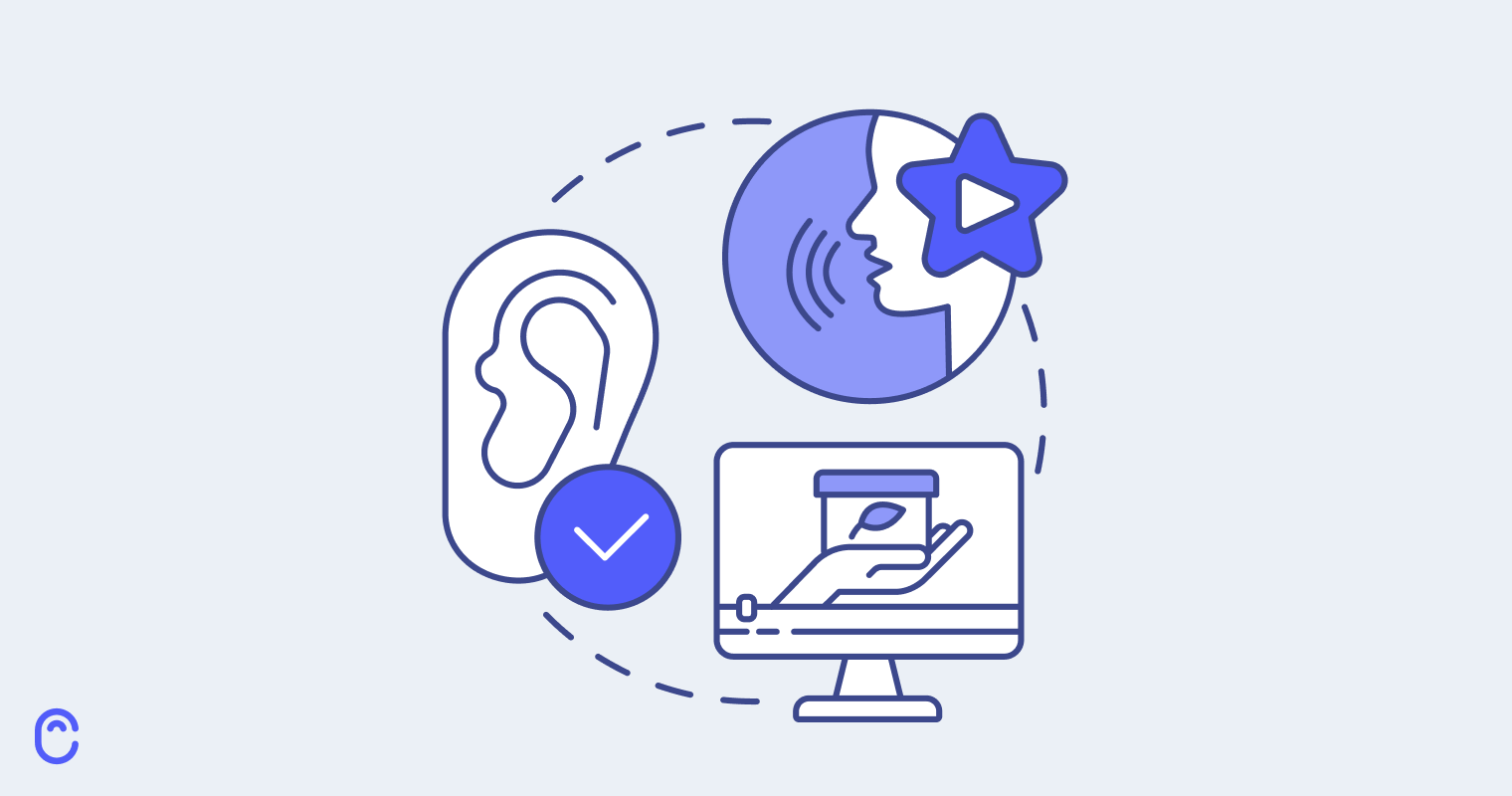People have dreamed about reading minds for ages. Wouldn’t that superpower make decisions, relationships, and life much easier?
What if you could know exactly what your customers think and need? That’s what the voice of the customer (VoC) methodology helps you do.
VoC is about collecting and understanding what customers say about your product. It means listening to their feedback and using it to improve.
“Understanding the voice of the customer directly influences how well we can meet and exceed our customer expectations.”
Julia Valade, customer success manager at Canny
When you truly listen to your customers, you can create products they love. VoC helps you build better products and make informed decisions.
“It’s shocking how many product managers don’t talk to their customers. That should be your first conversation.”
Mike Marriage, head of product at Bloomerang
Talking to your customers helps you understand their needs and solve their problems. This makes them happier and more loyal.
So, nothing really new here, right? You’ve know how important feedback management is. So, we’ve decided to explore this framework from a mindset perspective.
What if you didn’t just use the voice of the customer methodology? What if you became the voice of the customer?
The mindset of being the voice of the customer
Imagine if every product decision you made came from your customers’ thoughts. You’d only build products that people love.
Until someone invents a mind-reading tool, we need a workaround. Many experts suggest using the voice of the customer framework to shape your mindset.
“It is very critical that you look at every feature and problem you’re trying to solve from the customer’s perspective. Ultimately, you are the voice of the customer in the organization.”
Mike Marriage, head of product at Bloomerang
Start with active listening.
“It’s important to actively listen and truly understand the deeper reasons behind their comments. This means not just hearing their words, but considering the context and what they’re trying to tell us.”
Julia Valade, customer success manager at Canny
This means not just hearing the words but grasping the underlying concerns.
Next, practice empathy. Put yourself in your customer’s shoes to better understand their needs and pain points. User feedback is instrumental here.
“By analyzing user feedback, we identified that students felt overwhelmed integrating new information with their existing knowledge. This led us to develop specific features like mind mapping and spaced repetition systems (SRS). This resulted in a 30% increase in user engagement and customer retention within three months.”
Dominic Zijlstra, founder of Traverse
Dominic’s story perfectly illustrates how listening to customers improves products. Being the voice of the customer means:
- Providing space for feedback, comments, suggestions, and ideas
- Having a dialogue with your users (through interviews and discussions)
- Collecting and organizing them all
- Prioritizing the most impactful ideas
- Continuously updating the users on the progress
- Actually building features they care about
- Telling them about it (closing the feedback loop)
- Doing all this continuously
This is where a tool like Canny comes in handy. It can help you do all that, automate parts of this process, and help you become a real feedback champion.
“I try to imagine a meeting. How can the client have a seat at that table? At the end of the day, they’re the primary stakeholder in product decisions. Canny gives the users a seat at that table alongside product, sales, support, marketing, etc. If I see a clear value-add to the product for just one user, I’ll put it on the Canny feedback board so other users can weigh in. From there, it’s up to the product team what they prioritize, of course, but my job is to ensure that the user’s voice is at least heard. And Canny does that.
Jacques Reulet, customer support at Canny
Advocating means pushing for changes that benefit your customers, even if it takes work.
“Give customers easy and clear ways to submit their feedback. Share user feedback with your product teams regularly and advocate for their needs. Clearly explain the value customers get from your products and any gaps or challenges they might be experiencing.”
Julia Valade, customer success manager at Canny
Lastly, commit to continuous learning. Regularly check in with your customers – set up ongoing feedback loops. Constant feedback helps you stay aligned with what your customers want.
How can you do that without overwhelming your customers, though? Getting a check-in email every week will likely end up in the trash very quickly. That’s why many product managers choose a tool like Canny.
“Canny has provided an interactive space where the users feel like they have a voice and are being listened to. It creates that long term relationship and loyalty we’re striving for.”
Chelsea Darby, customer success lead at Aryeo
Adopt this mindset, and you won’t just use the VoC methodology. You’ll become the voice of the customer – a real champion of feedback and an advocate for your customers.
Let’s break down this methodology further.
Voice of the customer program objectives
You need clear objectives to get the best results from the Voice of the Customer (VoC) program. Typically, there are three main goals with this program:
- Improve your product and features
- Enhance customer service
- Increase customer satisfaction and loyalty
Improve your product and features
Improving your product can mean lots of different things. You might think you’re improving, but you might end up building a feature no one uses.
That’s why it’s imperative to collect and prioritize user feedback. Focusing on the most impactful suggestions can lead to meaningful changes.
“We rely on app ratings, feedback from our regular users, and issues we receive via email or support tickets. Then, we share and discuss these requests with our development and support teams. Based on this input, we prioritize bug fixes, feature requests, and other similar improvements.”
Stefan Chekanov, co-founder and CEO of Brosix
Enhance customer service
When you follow through on customer feedback, this happens naturally. Your users will feel heard and valued.
“I hold regular check-ins and review sessions with customers to discuss their experiences and gather direct feedback. I then share customer insights with our product and engineering team to inform adjustments or new features. I also use feedback to refine customer calls and processes.”
Julia Valade, customer success manager at Canny
This may all sound great, but how can you know you’re improving customer service? Once again, ask your customers. Chances are, they want to tell you how you’re doing. For example, you can add a quick customer survey at the end of every live chat.
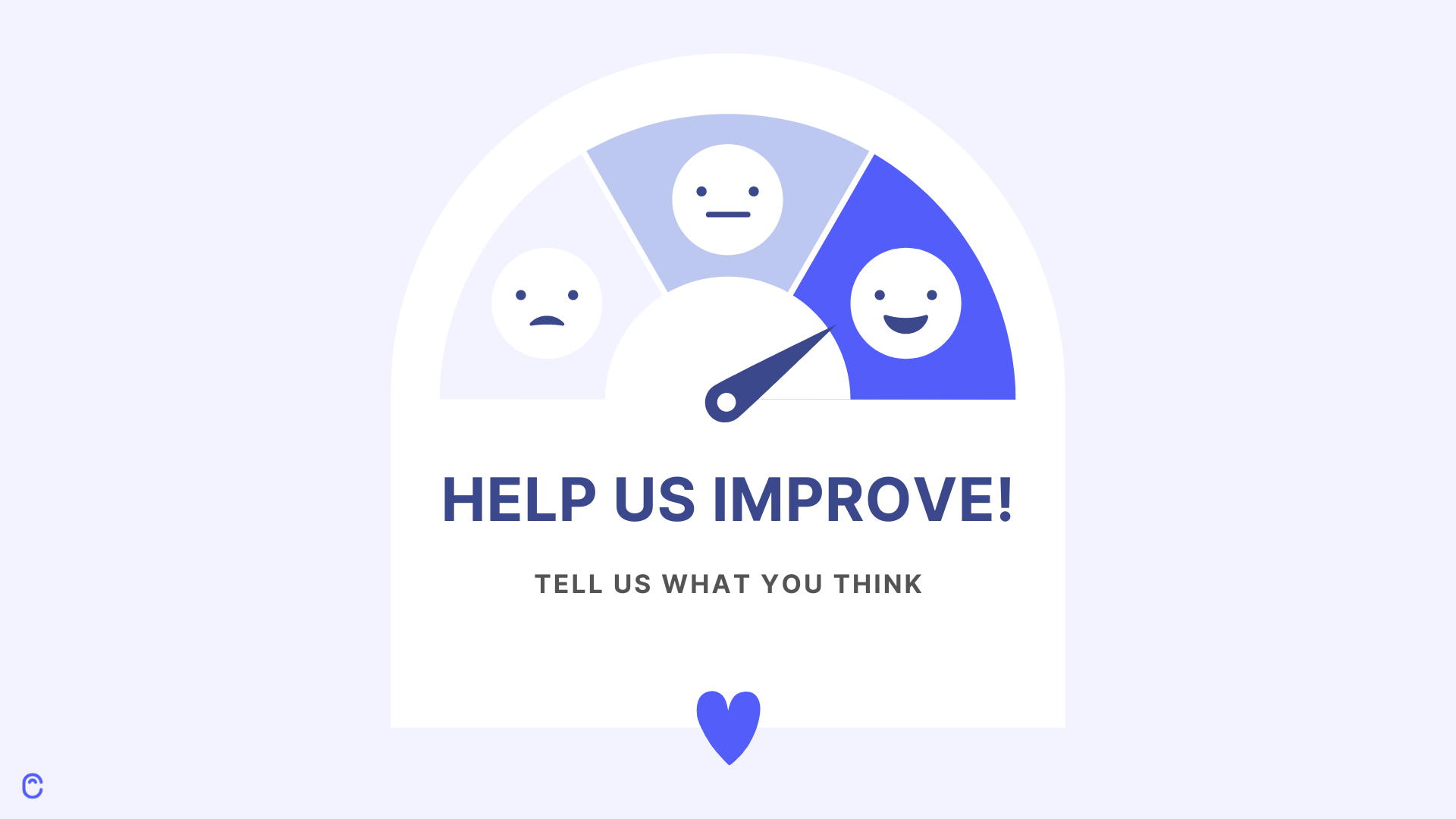
Increase customer satisfaction and loyalty
When customers see that their feedback leads to real changes, they feel valued and heard. This builds long-term relationships.
“When we listen to what [our users] want, we can make changes that meet their specific needs. This makes them feel valued and keeps them coming back.”
Derek Pankaew, founder of Listening.com
By staying in tune with your customers’ needs, you create a loyal customer base that trusts your brand.
When you consistently gather and act on user feedback, you’ll achieve all three objectives simultaneously. Let’s discuss how you can measure the impact of your actions now.
Common VoC metrics
You need to track key metrics to see how well your Voice of the Customer (VoC) program works. These metrics show customer happiness and loyalty.
Net Promoter Score (NPS)
This metric shows customer loyalty. You ask customers, “How likely are you to recommend our product to a friend?” on a scale of 0 to 10. Then, you group customers into the following buckets:
- Promoters: 9-10
- Passives: 7-8
- Detractors: 0-6 are detractors.
Subtract the percentage of detractors from the percentage of promoters to get your NPS. A higher NPS means more loyal customers.

Customer Satisfaction (CSAT)
This metric measures how satisfied customers are with a specific interaction. After a customer interaction, like a support call, ask customers to rate their experience on a scale from 1 to 5. A higher customer satisfaction score means happy and loyal customers. CSAT helps you understand customer feelings about specific parts of your service.
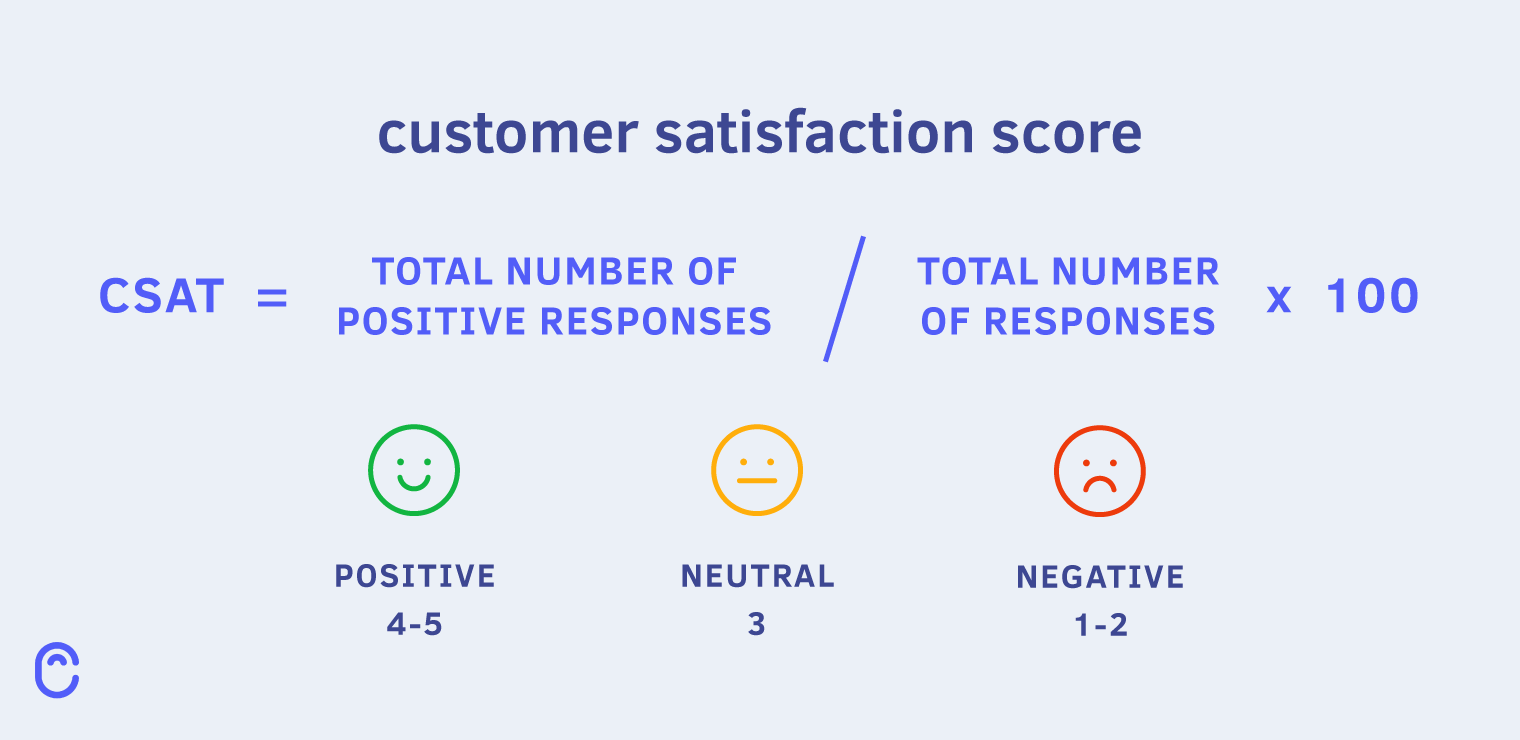
Customer Effort Score (CES)
CES measures how easy it is for customers to achieve their goals with your product. You ask customers if they agree with the statement:
“The company made it easy for me to handle my issue.”
Lower effort scores mean a smoother customer experience. CES helps you find and fix points of friction in the customer journey.

Track these metrics to see where you can improve your product and services.
Now that we are absolutely certain that we need to gather feedback, let’s discuss the “how.”
How to gather customer feedback
To better understand your customers, you need to gather their feedback in different ways. Using only one method might leave you blindsided.
Different customers prefer to give you feedback in different ways. Let’s go back to empathy for a second – put yourself in your customers’ shoes. Maybe you always fill out that post-call survey. Or perhaps you delete it right away. What would make you leave feedback?
The key is this: give your users options.
“To incorporate VoC into day-to-day operations, I recommend setting up multiple feedback channels such as surveys, email feedback, and forums. Analyze the data to identify recurring themes and actionable insights.”
Dominic Zijlstra, founder of Traverse
Here are a few feedback channels you can try.
Feedback portal
Use a dedicated feedback portal like Canny. This lets customers to submit their ideas, comments, and suggestions. They can also upvote existing ideas and follow your product development journey.
Then, you get to the bottom of each feature request, can have a dialogue with your users, and keep them engaged.
Customer interviews
Talk directly to your customers to get deep insights.
“We reach out, we interview, find out what [our users] are doing, what they are up to, what they are hearing, and what trends are.” These chats can reveal valuable details.”
Amanda Laferriere of C2FO
Focus groups
Bring together a small group of customers to discuss your product. This can help you understand their thoughts and feelings in a more dynamic setting.
Customer support chats
Use interactions with support teams to get real-time feedback. These chats help identify common issues and areas for improvement.
Bonus: you can extract feedback from those chats automatically. A tool like Canny Autopilot can find feedback, extract it, add it to your Canny board, and then even deduplicate it.
Online reviews
Read reviews on platforms like the App Store or Google Play. Reviews give you a sense of how customers see your product and highlight both positives and areas that need work.
“For me, the “voice of the customer” is all about understanding what your users really think. For us, it’s like diving into app user reviews and finding out what our users love (or don’t love). These reviews give us a peek into their experiences, helping us see things from their perspective.”
Derek Pankaew, founder of Listening.com
Coming soon: Canny Autopilot will soon be able to extract feedback from online reviews, too. Stay tuned!
Surveys
Send out customer surveys to collect structured feedback. You can ask specific questions to gather customer data on satisfaction and preferences.
Surveys can appear in-app after a user takes a specific action. You can also add them at the end of your customer support chat.
Social media
Monitor social media channels to see what customers are saying about your product. This is a great way to gather unsolicited feedback and engage with users.
On social, users aren’t always expecting to hear back. If you engage, you might pleasantly surprise them and stand out.
Website behavior
Analyze how customers navigate your website to understand their journey and find any friction points. This customer behavior can guide user experience improvements.
For example, your customers might be using a feature in a way you didn’t intend. This may lead to confusion and frustration. If you can detect it, you can then reach out, provide helpful tutorials, and improve your tool.
Sales, support, and success calls
Feedback from these calls can reveal valuable insights about customer needs and challenges. Gather and analyze this feedback to improve your service.
Bonus: once again, Canny Autopilot can automatically find feedback in these channels. You won’t need to spend time adding that feedback to your portal anymore. Now, all feedback will automatically appear in one central place. Plus, it’ll be deduplicated and ready to use!
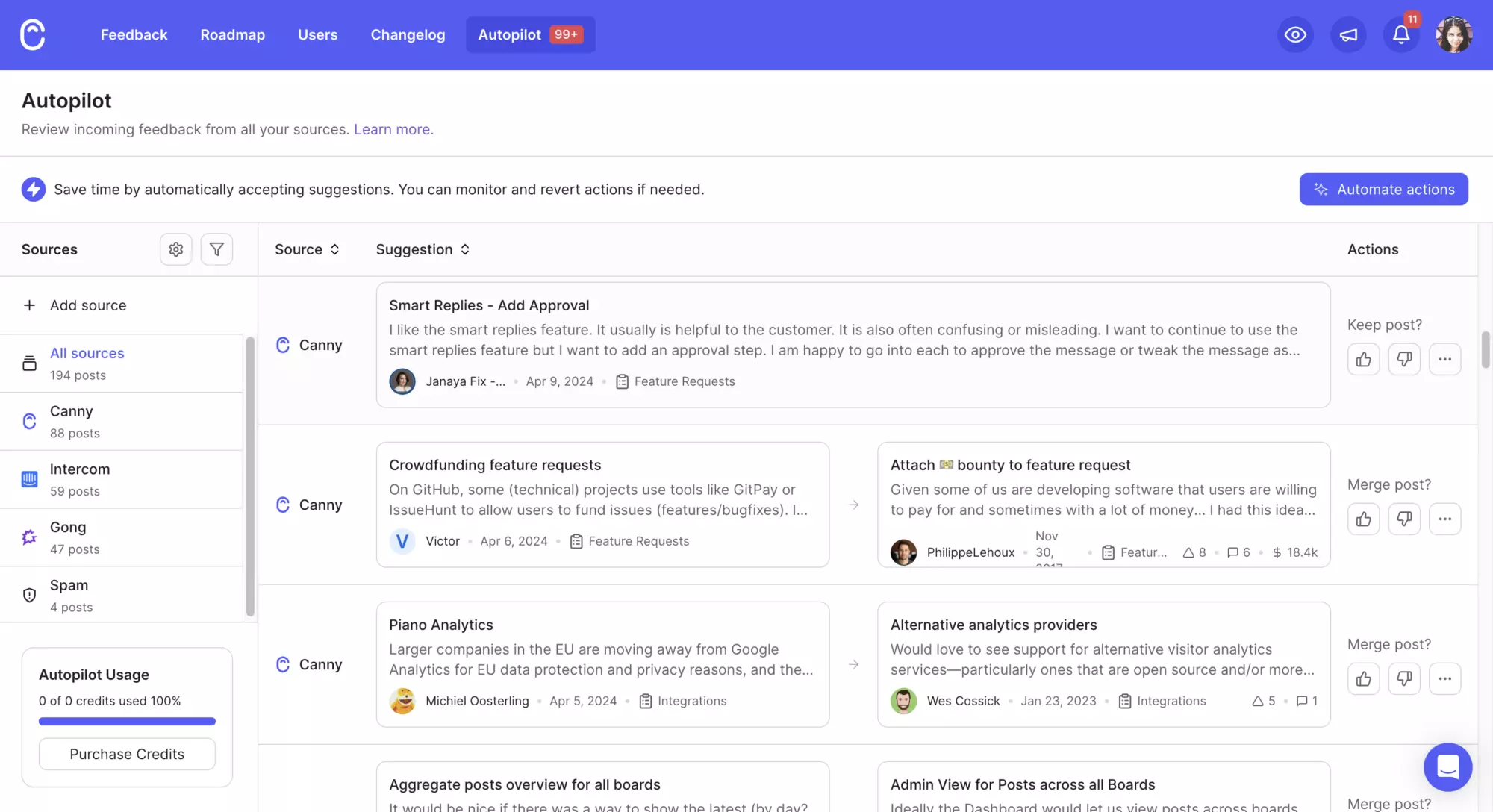
Emails
Encourage customers to share their thoughts and suggestions via email. This can provide detailed insights. Whenever you can, add a line about feedback to your emails. Your users will feel like you’re open to their suggestions.
Analyzing and prioritizing feedback
It’s one thing to gather your customers’ feedback. It’s another thing to analyze it and really understand it. Analyzing your feedback lets you get to the root of your customers’ challenges.
How to analyze qualitative and quantitative feedback
Start by categorizing feedback into qualitative and quantitative types. Qualitative feedback includes comments and suggestions that provide detailed insights into customer experiences. Quantitative feedback includes metrics and ratings that you can measure and track.
For qualitative feedback, look for common themes and patterns. This helps you understand the underlying issues and customer needs. Tools like text analysis software can help identify recurring words and phrases.
You can analyze quantitative feedback through statistical methods. Look at average ratings, NPS scores, and other metrics to identify trends. This data can show you how widespread certain issues are and how your customers feel overall.
Prioritize feedback based on impact and feasibility
Not all feedback is equally important. To prioritize, consider both the impact and feasibility of each suggestion.
When you really understand your customers’ needs, you can make the case to prioritize their feature requests. Make sure your prioritization formula factors in the impact feedback has on key customers.
High-impact changes will make a big difference to many users. Feasible changes are improvements you can make with the resources you have.
Create a matrix to map out feedback based on these two criteria. Focus on changes that are both high-impact and feasible. These are the ones that will provide the most value with the least effort.
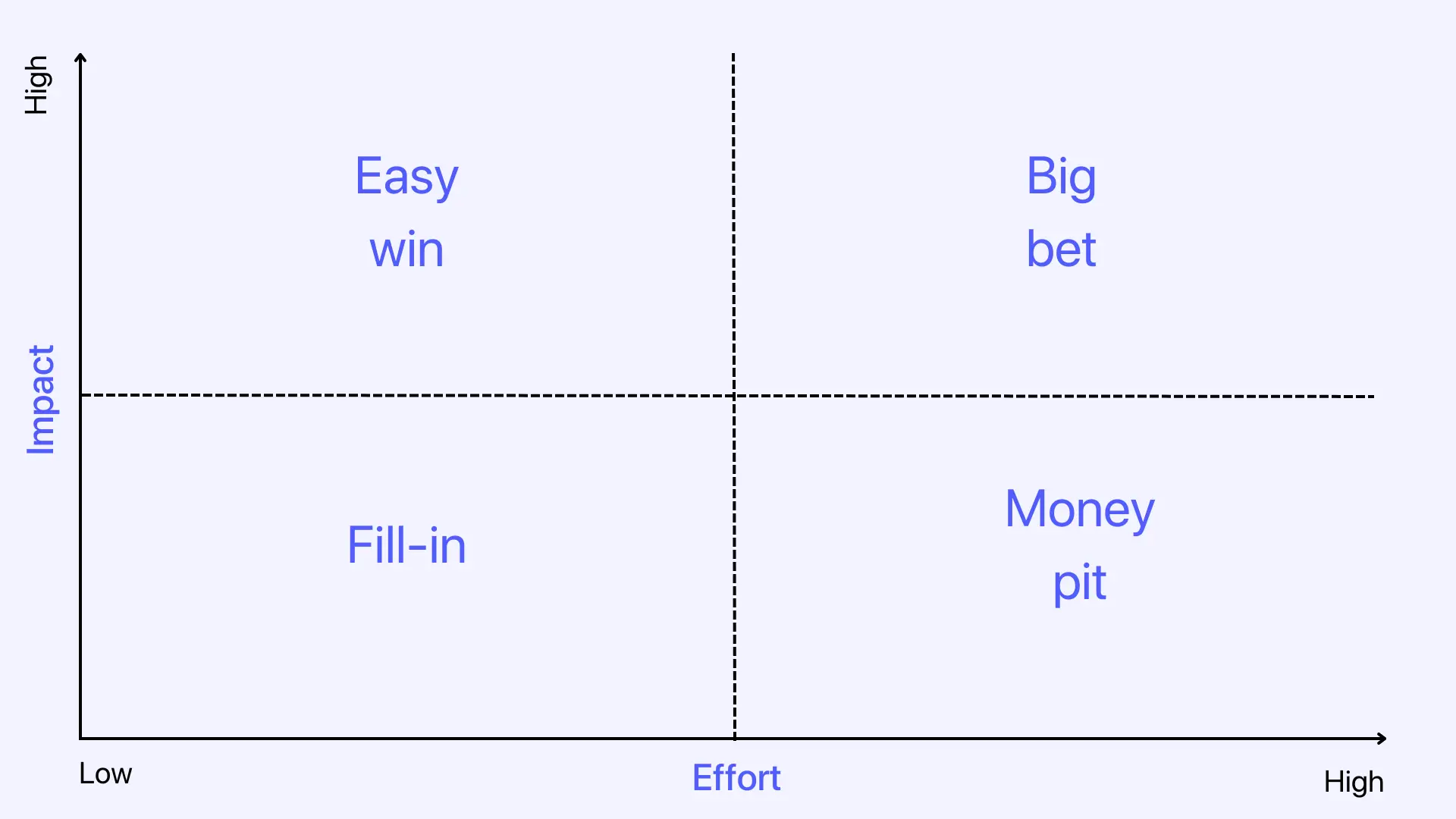
Using a tool like Canny can streamline this process. Canny helps you collect, organize, and prioritize feedback in one place. It also makes it easy to track progress and keep users informed about the status of their suggestions.
“If it weren’t for Canny, we’d have to hire a product manager way sooner. The whole team and I save so much time by cataloging and triaging feedback so easily. I never want to go back to pre-Canny days.”
Evan Kirkham, co-founder of Outlier
Integrating VoC into product development
We’re doing all this to improve our products. That’s the real goal here. So use all the feedback you get to inform your product decisions.
Here’s how you can integrate customer feedback into your product roadmap.
Make it a habit to include customer insights in your product planning meetings. Remember – you are the voice of the customer!
Your team can’t address every piece of feedback at once. Use a system to prioritize changes based on impact and feasibility. Tackle high-impact, easy-to-implement changes first – the low-hanging fruit. You can make significant improvements without overloading your team.
“VoC gives us real insights that help us create an even better customer experience. Without a nuanced understanding of our users, we’d be shooting in the dark, developing features without any real direction.”
Stefan Chekanov, co-founder and CEO of Brosix
Always close the loop with your customers. Let them know how their feedback has influenced your product decisions. This builds trust and encourages more feedback in the future.
“Lastly, close the feedback loop. Always let customers know how you used their feedback. This strengthens their trust, promotes engagement, and improves your relationship.”
Julia Valade, customer success manager at Canny
Use tools like Canny to document feedback and track progress. This helps keep everyone on the same page and ensures no customer insight gets lost.
Don’t just use VoC; be VoC
Many articles talk about using the voice of the customer framework. We encourage you to become the voice of the customer.
This means making every product decision with your customers’ needs in mind. By truly listening and acting on feedback, you create products that your users love.
Canny can help make this process easier. It organizes feedback, helps you prioritize changes, and keeps customers in the loop. You can save time and make sure every piece of feedback counts.
You no longer have to dream about reading your customers’ minds. You can find out exactly what they’re thinking and tailor-make your product just for them.
Try Canny today to streamline your VoC efforts and become a true advocate for your customers.


